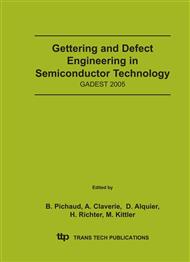p.735
p.741
p.749
p.755
p.761
p.767
p.773
p.779
p.787
SiGe Light-Emitting Diodes and Their Characteristics in the Region of Band-to-Band Transitions
Abstract:
Light-emitting diodes (LEDs) based on single crystal SiGe with the Ge content of 5.2% were fabricated using a planar technology. Their electroluminescence (EL) parameters were studied over a wide range of measured currents (up to 11 A) and temperatures (80 - 300) K. The integrated EL intensity at a fixed current increased approximately two times with temperature increasing from 80 to 200 K and changed insignificantly in the temperature range of 200 – 300 K. The analysis of the EL spectra shows that the recombination involving excitons is the dominant mechanism of radiative recombination at both no-phonon and phonon-assisted transitions in SiGe LEDs not only at low temperature but at room temperature, too. The linear dependence of the integrated EL intensity on the current and the exponential decay of the integrated EL intensity confirm this conclusion. The room temperature internal quantum efficiency of EL in the region of band-to-band transitions is estimated to be 0.5%. A sublinear current dependence of the integrated EL intensity and a fast decay of the integrated EL intensity after the diode turn-off were observed at room temperature and currents > 2.5 A. The effect is associated with the appearance of an additional (Auger) mechanism of non-radiative recombination parallel to Shockley-Read-Hall recombination.
Info:
Periodical:
Pages:
761-766
Citation:
Online since:
December 2005
Price:
Сopyright:
© 2005 Trans Tech Publications Ltd. All Rights Reserved
Share:
Citation:


